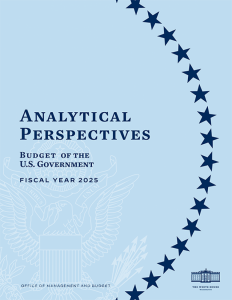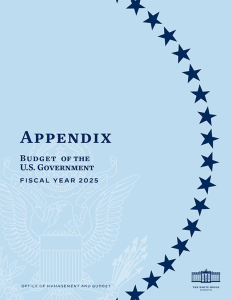
Every year since 1921, when the Budget and Accounting Act gave the President of the United States the overall responsibility for planning the annual Budget of the United States Government, the Government Publishing Office (GPO) has worked with the White House Office of Management and Budget (OMB) to produce and distribute the President’s budget proposals for the coming fiscal year.
The President’s Budget for Fiscal Year 2025, which runs from October 1, 2024 to September 30, 2025, is now available for anyone with access to a computer to read online for free. GPO has signed and certified the PDF files to assure users that these online documents are official and authentic. They should be viewed using Adobe Acrobat or Reader version 7.0 or higher.
Sycamore Library will not be receiving a paper copy of this document this year, but a paper copy of the U.S. Government for Fiscal Year 2025 can be pre-ordered from the U.S. Government Bookstore if you would like to purchase your own personal copy.
FACT SHEET: The President’s Budget for Fiscal Year 2025 is a press release from the White House Briefing Room that highlights economic achievements of the past year of the Biden administration and details the President’s vision to reduce taxes for lower- and middle-income Americans; lower costs for prescription drugs, child care, education, and housing; protect and strengthen Social Security and Medicare; invest in America and the American people to make sure the middle class has a fair shot and no one is left behind; and reduce the deficit by “cracking down on fraud, cutting wasteful spending, and making the wealthy and corporations pay their fair share.” Among the proposed spending increases are mental healthcare programs for veterans; infrastructure improvements; worker protection and empowerment programs; clean energy projects; increased border security; and provision of international humanitarian assistance as well as support against aggression and terrorism.
The Budget Process
The U.S. Constitution gives Congress the “power of the purse,” but does not prescribe how that power is to be exercised, nor does it provide a specific role for the President with regard to budgetary matters. Instead, various statutes, congressional rules, practices, and precedents have been established over the years to create a complex system in which multiple decisions and actions occur with varying degrees of “coordination” (to put the matter politely). As a consequence, there is no single definitive “budget process” through which all budgetary decisions are made.
This oversimplified list of steps, therefore, can provide a general idea of how the federal budget is created and implemented, but keep in mind that the reality is never so orderly or linear:
Formulation of the President’s Budget
- Executive agencies submit their requests for funds to the Office of Management and Budget.
- The President reviews these requests and makes the final decisions on what will go into the proposed budget.
- The budget documents are prepared and sent to Congress. (These are the documents described in this post.)
Action by Congress
- Congress reviews the President’s budget and passes a budget resolution, setting total spending levels for the year. (They may follow, modify, or reject the President’s recommendations.)
- Within the framework of the budget resolution, individual committees prepare detailed appropriations bills to provide funding for specific purposes. Other legislation affecting spending and revenue is also developed.
- The House and Senate work out their differences and enact the appropriations bills.
- The President signs the bills and the budget is now law.
- The fiscal year begins.
Execution of the Enacted Budget Laws
- Agency program managers execute the budget they have been provided.
- Data are collected on how much the government actually spends and receives.
For a more detailed description of the budgetary process that occurs today and how it developed over the years, see the Congressional Research Service report Introduction to the Federal Budget Process. The appendices in this CRS report include a glossary of budget-process-related terms and a flowchart of congressional budget process actions.
If you would like to track how government agencies and programs make use of this budgeted money once they have received it, visit USAspending.gov, “the official source of government spending data.”
Organization of the Budget
The Budget of the United States Government is divided into three main volumes and is accompanied by several supporting documents and supplemental materials provided to enhance one’s understanding of the Budget.

Budget of the U.S. Government, Fiscal Year 2025
The title volume—a scant 181 pages long this year—is by far the most succinct volume. It contains the Budget Message of the President, information on the President’s priorities and vision for the future, and summary tables of the President’s proposed plans for the budget and any recommended taxes.

Analytical Perspectives
This volume provides analyses that highlight specific subject areas or provide other significant presentations of budget data to place the budget in perspective.
Here you will find
- Economic and accounting studies
- Information on federal receipts and collections
- Analyses of federal spending
- Information on federal borrowing and debt
- Baseline or current services estimates
- Other technical presentations

Appendix
An Appendix to the Budget of the U.S. Government might sound like an afterthought, but it is the bulkiest volume and presents the most detailed information about the individual programs and appropriation accounts that constitute the budget. It is intended primarily for use by the congressional appropriations committees, since they are the ones who will make the final decisions about how much money will be spent and on what.
The Appendix includes
- The text of proposed appropriations language for each government department and agency
- Budget schedules for each account
- New legislative proposals
- Narrative explanations of what work is to be performed and what funds are needed
- Proposed general provisions applicable to the appropriations of entire agencies or groups of agencies
The Appendix also provides information on certain activities whose transactions are not part of the budget totals.
Supplemental Materials
Several additional supporting documents provide data useful for understanding the budget, and more of these documents will be added as the information becomes available. The specific documents provided will vary from year to year. Among these many supplemental documents are the following:
- Historical Tables provide data on budget receipts, outlays, surpluses or deficits, federal debt, and federal employment over an extended time period, generally from 1940 or earlier to several years into the future. The data are adjusted as much as possible to be consistent with the current budget and to provide comparability over time.
- Climate Financial Risk: The Federal Government’s Budget Exposure to Financial Risk Due to Climate Change is an assessment of the federal government’s climate risk exposure to help address the threat that climate change poses to the economy. This white paper is developed by the director of the Office of Management and Budget (OMB) and the chair of the Council of Economic Advisors (CEA) in consultation with several other agencies and published annually as part of President Biden’s Budget.
Budgets for Previous Years
Explore the Budget of the United States Government for Fiscal Years 1996 to the present at the GovInfo.gov website.
Historical editions of the Budget of the United States Government from 1921 to 2023 are available on the Federal Reserve Archival System for Economic Research (FRASER) website. Be aware that this is not an official version of the Budget of the United States Government, and neither the authenticity nor the completeness of the data can be guaranteed. FRASER is provided through a partnership between GPO and the Federal Reserve Bank of St. Louis. (Note also that the dates of the Appendix and Special Analysis volumes may differ.)
Paper copies of the Budget of the United States Government are available at Sycamore Library. Ask at the Sycamore Service Desk for assistance with finding and using these.
Would You Like to Know More?
Visit us in the Sycamore Library at UNT, or send us a message at govinfo@unt.edu if you have any questions or would like more information about the U.S. Budget or any other federal, state, or local government information.
Article by Bobby Griffith.


Lula Westbrook
You have made the 2025 budget riveting and exciting to READ.
The layout is comforting to the eye.
The content and context heading alone is cause for me to want to delve into.
On this Friday morning I will be complementing poetry with jazz first.
Both articles are simply beautiful . It will be poetry first.
While you’re in conference, I’ll be reading the 3 inch BUDGET. And, combing through with a fine tooth comb.
Have a Great Conference week!